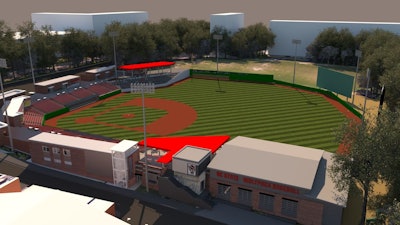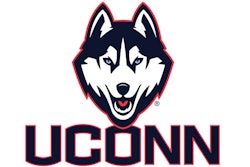 Doak Field at Dail Park Stadium enhancementVia NC State University
Doak Field at Dail Park Stadium enhancementVia NC State University
For years, the N.C. State baseball team has competed with the best. During the same period of time, fans have wondered what the ceiling was for the program if it had facilities that matched some of the top teams in the nation. Pretty soon, Wolfpack Nation will find out.
The Doak is getting an upgrade. On Thursday, N.C. State athletics announced a $15 million enhancement plan for Doak Field. The first phase will start at the end of the 2022 season.
“The times here,” Wolfpack baseball coach Elliott Avent said in a video message. “We want to build something that’s right, and we want to do it the right way.” Avent added that it was time for a stadium that the fans and former, current and future players deserve.
Upgrades will be broken into three compartments: Competitive team performance spaces (locker room, lounge, weight room, batting facility, pitching lab); facility improvements (playing surface, LED lighting, scoreboard upgrade, bullpens, branding); and fan experience (seating, entertainment space, concession upgrades). According to a release from the school, the Wolfpack Club initiated a fundraising effort to get the process started. New donors and volunteers are welcomed and more information on how to donate can be found at gopack.com/Pack9Stadium. — The Herald Online
 Berendo Middle School New Gymnasium
Berendo Middle School New Gymnasium
Opened in 1910 in Los Angeles, Berendo is the oldest California middle school continuously operating on the same site. The Los Angeles Unified School District selected CO Architects to design the new free-standing gymnasium and renovate an existing administrative space into a mental health clinic.
The new gym, playfield, and plaza sustainably extend Berendo’s service to its more than 800 students and the neighboring communities. The school has nearly 100 percent minority enrollment, the majority of students being Hispanic and economically disadvantaged.
The design brief called for an approach that celebrated and facilitated the connection between Berendo’s compact urban campus, which shares space with the Monsignor Romero Charter School, and the surrounding community. The new gymnasium was sited and designed to offer multiple uses, including fitness, assembly, and social space for both school and neighborhood functions.
The gym’s flat roof turns down at the edges to become a part of the façade compositions on the east and west sides. The balcony on the north side, along with extensive north-facing glazing, provides a visual connection to nearby Wilshire Boulevard and offers views of the downtown skyline.

An interior corridor in the gymnasium building features a colorful geometric pattern in yellow, white, and blue vinyl, with the pattern repeated in wet areas in tile. (Yellow and white were the original school colors; blue is the current school color.) In the gym itself is a graphic that reads “Charging Forward Since 1910 BERENDO” in large blue letters, while wide vertical stripes of dark and light blue and yellow line the bleachers; the light-blue stripes sport white images of base-, basket-, volley-, soccer-, and footballs. Just outside of the gym, more wall graphics explain the building’s sustainable aspects, giving students assurance that their space is ecologically responsible.
The architects incorporated several sustainability features identified by CHPS (Collaborative for High Performance Schools) in the new gym. Throughout the project, structural members were made from recycled steel that might otherwise have gone to landfills. The steel studs were covered with rigid insulation and then plaster, creating a wall assembly that exceeds the R-value (thermal resistance) required by code and minimizes the energy required for HVAC operation. Further, a cool roof was created by adding a reflective membrane that lessens heat transfer into the building. The gym has several solar tubes, which direct natural light into the building and reduce the need for artificial lighting. The large, north-facing, three-story window wall brings in northern light in without contributing to heat gain from the sun.

The project brief called for the development of the landscape to “green” the campus and expand an existing community garden. The new resilient fescue grass playfield is a rare amenity for an inner-city school, and helps mitigates the heat-island effect produced by paved playgrounds. A new central plaza with shade trees in large circular planters serves as an informal community meeting area. Between the plaza and the school entrance is the expanded learning garden with educational signage. It was planted with drought-tolerant species surrounding a zig-zagging ADA-compliant ramp, which ties together the lower and upper parts of the campus. These completed green spaces provide a community amenity conspicuously lacking in this dense urban setting devoid of public parks.
“Physical fitness is a healthy part of how kids learn, and this gym is going to bring a much needed opportunity to continue that program,” says Rosa Trujillo, Principal, Berendo Middle School. “My favorite place is the balcony. To be able to see the downtown skyline of Los Angeles, to be able to see the Hollywood Hills, it’s like you can look out to those areas and dream of what you’re going to be in the future, who you’re going to be in Los Angeles, and how you’re going to contribute to our city.”
LAUSD Berendo from CO Architects on Vimeo.
 Richard L. Duchossois Athletic and Recreation CenterCannonDesign
Richard L. Duchossois Athletic and Recreation CenterCannonDesign
Washington & Lee University in Lexington, Va., along with firm CannonDesign, have renovated the indoor athletics facility into a modern, leading-edge space for students and staff.
The result is the dynamic Richard L. Duchossois Athletic and Recreation Center spanning 161,000 square feet across five floors.
 Richard L. Duchossois Athletic and Recreation CenterCannonDesign
Richard L. Duchossois Athletic and Recreation CenterCannonDesign
Interior spaces include fitness areas, a competition basketball court, wrestling room, team locker rooms, an athletic training facility, racquetball and squash courts, golf training spaces, a lacrosse area and an equipment room. CannonDesign took great care in reorganizing programming spaces to maximize adjacencies and synergies.
 Richard L. Duchossois Athletic and Recreation CenterCannonDesign
Richard L. Duchossois Athletic and Recreation CenterCannonDesign
The rejuvenated center now serves Washington & Lee University as an exciting space for student life and wellness, a campus visual icon and a tool for recruitment and retention. The project ensures the university can best help students live healthy lives for decades to come. — CannonDesign
Duchossois Athletic and Recreation Center Tour from Washington and Lee News on Vimeo.




































